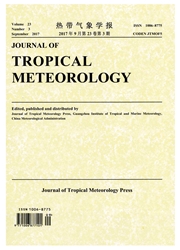

 中文摘要:
中文摘要:
This work investigates the distribution of high winds above Beaufort scale 6 in the offshore zones of China using high-resolution satellite measurements.A numerical experiment is carried out in order to find out the effects of Taiwan Island on the formation of strong winds.The analysis indicates that the distribution of high wind occurrence is similar to that of the average wind velocity in winter.High winds tend to be anchored in special topographical regions,such as the Taiwan Strait,the Bashi Channel and the southeast coast of Vietnam.High winds occur much more frequently over the warmer than the colder flank of Kuroshio front as it meanders from Taiwan to Japan.The frequency of high winds decreases drastically in spring.The Taiwan Strait maintains the largest high wind occurrence.Besides,high winds remain frequent in the Bashi Channel,the southeast tip of Taiwan Island and the warmer flank of Kuroshio front.In summer,high winds generally occur infrequently except over a broad region off the southeast coast of Vietnam near 10°N and the frequency there decreases from southwest to northeast.High winds around Taiwan Island present near axisymmetric distribution with larger frequency along southeast-northwest direction and smaller frequency along southwest-northeast direction.The dominant direction of high winds exhibits a counterclockwise circulation surrounding the island.The frequency of high winds increases rapidly in autumn and almost repeats the distribution that appears in winter.The simulation results suggest that the effects of Taiwan Island topography on high winds vary with seasons.In winter,topography is the major cause of high winds in the surrounding oceanic zones.High winds in both Taiwan Strait and the southeast corner of the island disappear and the frequency decreases gradually from south to north when the terrain is removed.However,in summer,high wind frequency derived from two simulations with and without terrain is almost identical.We attribute this phenomenon to the factors which are respon
 英文摘要:
英文摘要:
This work investigates the distribution of high winds above Beaufort scale 6 in the offshore zones of China using high-resolution satellite measurements.A numerical experiment is carried out in order to find out the effects of Taiwan Island on the formation of strong winds.The analysis indicates that the distribution of high wind occurrence is similar to that of the average wind velocity in winter.High winds tend to be anchored in special topographical regions,such as the Taiwan Strait,the Bashi Channel and the southeast coast of Vietnam.High winds occur much more frequently over the warmer than the colder flank of Kuroshio front as it meanders from Taiwan to Japan.The frequency of high winds decreases drastically in spring.The Taiwan Strait maintains the largest high wind occurrence.Besides,high winds remain frequent in the Bashi Channel,the southeast tip of Taiwan Island and the warmer flank of Kuroshio front.In summer,high winds generally occur infrequently except over a broad region off the southeast coast of Vietnam near 10°N and the frequency there decreases from southwest to northeast.High winds around Taiwan Island present near axisymmetric distribution with larger frequency along southeast-northwest direction and smaller frequency along southwest-northeast direction.The dominant direction of high winds exhibits a counterclockwise circulation surrounding the island.The frequency of high winds increases rapidly in autumn and almost repeats the distribution that appears in winter.The simulation results suggest that the effects of Taiwan Island topography on high winds vary with seasons.In winter,topography is the major cause of high winds in the surrounding oceanic zones.High winds in both Taiwan Strait and the southeast corner of the island disappear and the frequency decreases gradually from south to north when the terrain is removed.However,in summer,high wind frequency derived from two simulations with and without terrain is almost identical.We attribute this phenomenon to the factors which are respons
 同期刊论文项目
同期刊论文项目
 同项目期刊论文
同项目期刊论文
 期刊信息
期刊信息
